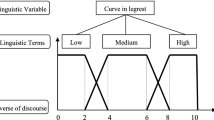Abstract
In this paper, a design reuse framework with a function-based design synthesis approach is proposed in the context of conceptual product development. Previous researches in design reuse have lacked a comprehensive functional base for knowledge representation and reasoning. The method presented in this paper uses a function-based product information model and a multiple objective optimization model to achieve design reuse. The information model is dependent on a functional core which is the key element vector. It is capable of modeling product information with sufficient abstraction, which in turn facilitates intelligent construction of product platforms. The multiple objective optimization method carries out automated design synthesis and evaluation subject to various design constraints. The approach has been applied in the design of the fan filter unit, a key clean room device. It has achieved intelligent design reuse in product conceptual design with significant rapidity and solution variety.
















Similar content being viewed by others
References
Andersson J, Wallace D (2002) Pareto optimization using the struggle genetic crowding algorithm. Eng Opt 34:623–644
Bobrow D, Falkenhainer B, Farquhar A,Fikes R, Forbus KD, Gruber TR, Iwasaki Y, Kuipers BJ (1996) A compositional modeling language. In: Proceedings of the 10th international workshop on qualitative reasoning. Menlo Park, AAAI Press, pp 12–21
Campbell M, Cagan J, Kotovsky K (1999) A-Design: an agent-based approach to conceptual design in a dynamic environment. Res Eng Des 11:172–192
Chakrabarti A, Bligh T (1996) An approach to functional synthesis of mechanical design concepts: theory, applications, and emerging research issues. Artifi Intell Eng Des Anal Manuf 10:313–331
Campbell M, Cagan J, Kotovsky K (2000) Agent-based synthesis of electromechanical design configurations. J Mech Des 122:61–69
Chen W, Allen JK, Mavris DN, Mistree F (1996) A concept exploration method for determining robust top-level specifications. Eng Opt 26:137–158
Chidambaram B, Agogino AM (1999) Catalog-based customization. In: Proceedings of the 1999 ASME design engineering technical conferences, Paper No. DETC99/DAC-8675, Las Vegas, Nevada
Deb K (2001) Multi-objective optimization using evolutionary algorithms. Wiley, New York
Fonseca C, Fleming P (1998) Multiobjective optimization and multiple constraint handling with evolutionary algorithms—part I: a unified formulation. IEEE Trans Syst Man Cybern Part A: Syst Humans 28:26–37
Fujita K, Yoshioka S (2003) Optimal design methodology of common components for a class of products: its foundations and promise. In: Proceedings of the 2003 ASME design engineering technical conferences and computers and information in engineering conferences, Paper No. DETC2003/DAC-48718, Chicago
Haykin S (1999) Neural networks: a comprehensive foundation. 2nd edn. Prentice Hall, Upper Saddle River
Kirschman CF, Fadel GM (1998) Classifying functions for mechanical design. J Mech Des 120:475–482
Martin M, Ishii K (2002) Design for variety: developing standardized and modularized product platform architectures. Res Eng Des 13:213–235
McAdams DA, Stone RB, Wood KL (1999) Function interdependence and product similarity based on customer needs. Res Eng Des 11:1–19
Mittal S, Frayman F (1989) Towards a generic model of configuration tasks. In: Proceedings of the 11th international joint conference on artificial intelligence. Detroit, pp 1395–1401
Nelson SA, Parkinson MB, Papalambros PY (2001) Multicriteria optimization in product platform design. J Mech Des 123:199–204
Otto K, Wood KL (2001) Product design techniques in reverse engineering and new product development. Prentice Hall, New Jersey
Pahl G, Beitz W (1996) Engineering design: a systematic approach. 2nd edn. Springer, London
Pratt MJ, Anderson BD (2001) A shape modeling applications programming interface for the STEP standard. Comput Aided Des 33:531–543
Pulm U, Lindemann U (2001) Enhanced systematics for functional product structuring. In: Culley S et al. (eds) International conference on engineering design (ICED 01) design research—theories, methodologies and product modelling. Professional Engineering Publishing, pp 477–484
Rezayat M (2000) Knowledge-based product development using XML and KCs. Comput Aided Des 32:299–309
Simpson TW (1998) A concept exploration method for product family design. Ph.D. Dissertation, Georgia Institute of Technology, Atlanta
Simpson T, Maier J, Mistree F (2001) Product platform design: method and application. Res Eng Des 13:2–22
Stone RB, Wood K (2000) Development of a functional basis for design. J Mech Des 122:359–370
Stone RB, Wood KL, Crawford RH (2000a) Using quantitative functional models to develop product architectures. Des Stud 21:239–260
Stone RB, Wood KL, Crawford RH (2000b) A heuristic method for identifying modules for product architectures. Des Stud 21:5–31
Suh NP (2001) Axiomatic design—advances and applications. Oxford University Press, New York
Szykman S, Sriram RD, Bochenek C, Racz J (1998) The NIST design repository project. In: Roy R, Furuhashi T, Chawdhry PK (eds) Advances in soft computing—engineering design and manufacturing. Springer, London, pp 5–19
Szykman S, Racz JW, Sriram RD (1999) The representation of function in computer-based design. In: Proceedings of the 1999 ASME design engineering technical conferences, Paper No. DETC99/DFM-8742, Las Vegas
Szykman S, Fenves SJ, Keirouz W, Shooter SB (2001) A foundation for interoperability in next generation product development systems. Comput Aided Des 33:545–559
Yu B, MacCallum K (1995) Modelling of product configuration design and management by using product structure knowledge. In: Proceedings of the 1st international federation for information processing working group 5.2 workshop on knowledge intensive CAD (KIC-1), Helsinki University of Technology, Helsinki
Zamirowski EJ, Otto KN (1999) Identifying product family architecture modularity using function and variety heuristics. In: Proceedings of the 1999 ASME design engineering technical conferences, Paper No. DETC99/ DTM-8760, Las Vegas
Author information
Authors and Affiliations
Corresponding author
Rights and permissions
About this article
Cite this article
Xu, Q.L., Ong, S.K. & Nee, A.Y.C. Function-based design synthesis approach to design reuse. Res Eng Design 17, 27–44 (2006). https://doi.org/10.1007/s00163-006-0015-5
Received:
Revised:
Accepted:
Published:
Issue Date:
DOI: https://doi.org/10.1007/s00163-006-0015-5




